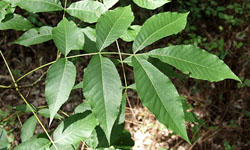Plant Profile: Pignut Hickory, Carya glabra
By Travis Ballard
This post is one of a series from professor Nisse Goldberg's Biology students at Jacksonville University.
Classification
Kingdom: Plantae
Division: Magnoliophyta
Class: Magnoliopsida
Order: Juglandales
Family: Juglandaceae
Genus: Carya
Specific epithet: glabra
Description
Carya glabra, pignut hickory, is a hardwood tree found along the eastern coast of North America. Pignut hickory is one of seven Carya species found in Florida, where it is common in both the central and northern portions of the state. At typically 60' in height and half that in width, this tree's oval-shaped canopy and sturdy branches provide the foundation for a terrific shade tree. It grows in mesic to dry hammocks, where it is often associated with oaks (Quercus spp.).
The leaves on a pignut hickory tree are odd-pinnately compound (usually with 5 or 7 leaflets) and deciduous (Figure 1). It is sexually monecious, so each tree produces both male and female flowers; in Florida, this happens around March. The male flowers are arranged in hanging catkins and the female flowers are formed in clusters at the tips of the branches; neither is particularly showy.
The pignut hickory fruit is a green, round to egg-shaped drupe which encloses a nut. One needn't worry about squirrels or other mammals placing undue weight on a sapling to harvest its rather bitter fruit, however - these trees may be 20-40 years old before bearing. C. glabra's fruit is easy to distinguish from that of Carya aquatica, the native water hickory, because of its smooth surface (Figure 3).
Uses
Carya glabra is used to make handles for tools, cabinets, and hardwood floors. These trees have also been used to construct wheels because their wood is dense, malleable, and shock-resistant.
Fun Facts
Early settlers named the fruits of this tree "Pignuts" because their hard, bitter nature made them not worth harvesting to eat... hogs, however, were rather fond of them. Abundant in wooded areas, and high in crude fat and protein content, the animals foraged on pignuts and quickly bulked up, which made their sale at the market all the more profitable. Oddly enough, when a pignut is split in half, it looks somewhat like a pig's snout (Figure 4).
Interested in growing your own? Consider purchasing from a member of the Florida Association of Native Nurseries. Be advised that this tree can live for over 100 years, so choose wisely when deciding where to plant it.
References
Image Sources
Figure 1. http://www.florida.plantatlas.usf.edu/plantimage/Carya_glabra5.jpg
Figure 2. http://www.florida.plantatlas.usf.edu/plantimage/Carya_glabra3.jpg
Figure 3. http://www.florida.plantatlas.usf.edu/plantimage/Carya_aquatica3.jpg
Figure 4. https://blogger.googleusercontent.com/img/b/R29vZ2xl/AVvXsEgTVJ0RXTyYGwdrIOPISOXWtBnjIXio8AIddE0x3yyqTopYKrryf2QyMwo5U21L4EMQGMXVeCtiyWT4kYopo0EhRqmeAL6dGUD5aNbQYfiyKwvH8MqiGlMK6GzqgcfJ4srqy_daG32zW80/s1600/013.JPG
This post is one of a series from professor Nisse Goldberg's Biology students at Jacksonville University.
 |
| Figure 1. Yellow-green leaflets on the compound leaf of C. glabra. Photo by Shirley Denton |
Kingdom: Plantae
Division: Magnoliophyta
Class: Magnoliopsida
Order: Juglandales
Family: Juglandaceae
Genus: Carya
Specific epithet: glabra
Carya glabra, pignut hickory, is a hardwood tree found along the eastern coast of North America. Pignut hickory is one of seven Carya species found in Florida, where it is common in both the central and northern portions of the state. At typically 60' in height and half that in width, this tree's oval-shaped canopy and sturdy branches provide the foundation for a terrific shade tree. It grows in mesic to dry hammocks, where it is often associated with oaks (Quercus spp.).
The pignut hickory fruit is a green, round to egg-shaped drupe which encloses a nut. One needn't worry about squirrels or other mammals placing undue weight on a sapling to harvest its rather bitter fruit, however - these trees may be 20-40 years old before bearing. C. glabra's fruit is easy to distinguish from that of Carya aquatica, the native water hickory, because of its smooth surface (Figure 3).
 |
| Figure 2 (left). Smooth fruit of C. glabra. Figure 3 (right). Ridged fruit of C. aquatica. Photos by Shirley Denton. |
Carya glabra is used to make handles for tools, cabinets, and hardwood floors. These trees have also been used to construct wheels because their wood is dense, malleable, and shock-resistant.
| Figure 4. Open fruit reveals a pig's snout. |
Early settlers named the fruits of this tree "Pignuts" because their hard, bitter nature made them not worth harvesting to eat... hogs, however, were rather fond of them. Abundant in wooded areas, and high in crude fat and protein content, the animals foraged on pignuts and quickly bulked up, which made their sale at the market all the more profitable. Oddly enough, when a pignut is split in half, it looks somewhat like a pig's snout (Figure 4).
Interested in growing your own? Consider purchasing from a member of the Florida Association of Native Nurseries. Be advised that this tree can live for over 100 years, so choose wisely when deciding where to plant it.
References
- http://plants.usda.gov/java/profile?symbol=cagl8
- http://dendro.cnre.vt.edu/dendrology/syllabus/factsheet.cfm?ID=19
- http://www.sfrc.ufl.edu/4h/Pignut_hickory/pignhick.htm
- http://www.herrinhs.org/Teachers/EricJohns/CHA07/Alicia%20Naulty/Pignut%20Hickory/Pignut%20Hickory.htm
- http://www.museum.state.il.us/muslink/forest/htmls/trees/C-glabra.html
Image Sources
Figure 1. http://www.florida.plantatlas.usf.edu/plantimage/Carya_glabra5.jpg
Figure 2. http://www.florida.plantatlas.usf.edu/plantimage/Carya_glabra3.jpg
Figure 3. http://www.florida.plantatlas.usf.edu/plantimage/Carya_aquatica3.jpg
Figure 4. https://blogger.googleusercontent.com/img/b/R29vZ2xl/AVvXsEgTVJ0RXTyYGwdrIOPISOXWtBnjIXio8AIddE0x3yyqTopYKrryf2QyMwo5U21L4EMQGMXVeCtiyWT4kYopo0EhRqmeAL6dGUD5aNbQYfiyKwvH8MqiGlMK6GzqgcfJ4srqy_daG32zW80/s1600/013.JPG



Comments